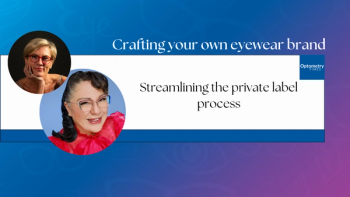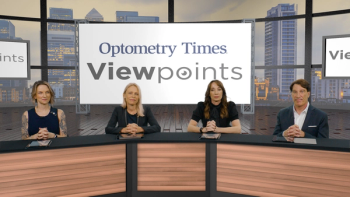
Vision Expo East 2025: An exclusive Q&A on finding the right fit for dual, contact lens wear – Part 2
Charissa Lee, OD, MBA, FAAO; Ryan Corte, OD; Roxanne Achong-Coan OD, FAAO, FIAOMC, FSLS, Dip CCLRT; and Nishan Pressley, OD; give their insights on distinguishing the best candidates for contact lens wear.
At Vision Expo East 2025, a group of panelists presented new data released by the Contact Lens Institute (CLI) on purchase factors driving contact lens searches online.1 In the first installment of a 2-part Q&A, Charissa Lee, OD, MBA, FAAO; Ryan Corte, OD; Roxanne Achong-Coan OD, FAAO, FIAOMC, FSLS, Dip CCLRT; and Nishan Pressley, OD share their insights in an exclusive interview with Optometry Times.
Jordana Joy:
What are the key identifiers in finding the best candidate, whether it’s dual wear or contact lens wear.
Nishan Pressley, OD:
I would say the number 1 characteristic would be motivation, right? If I'm telling you that this is an option and you're getting excited about it, okay, great. I got you. Let's do it. But that apprehensive, super anxious patient, "I can't even put drops in my eyes. I'm thinking about it, but I can't put drops in my eyes." That's going to be a longer conversation, of course, but ultimately, really just that motivation to want to wear contacts and see if it works for them. I think that's the number 1 characteristic I look for, that excitement behind trying something new.
Roxanne Achong-Coan OD, FAAO, FIAOMC, FSLS, Dip CCLRT:
“Yeah, and even if they're excited and afraid, so, for example, patients with a high prescription. They're thinking, "Oh, man, are these going to feel thick on my eyes too?" The reality is, they come in and they say, "Wow, I put these on and everything looks bigger, right?" This is like the real size world. And also they don't have the peripheral vision, just to cost me some supplementals, they're excited about too. So I think patients like those will be ideal candidates for contact lenses.
Ryan Corte, OD:
I do believe, too, that the industry has done a nice job advancing the technological innovations that have taken place with contact lenses. So, I had a patient when I asked her on a scale of 1 to 10 how interested are you? And she was, like, 30 or 40, if I remember correctly– mid 30s – dropped out of contacts years ago because they just weren't meeting what she needed. They weren't comfortable. A lot has changed in that time frame. And, she was anew patient to me. So I said, "Have you tried X, Y, or Z?" And we were able to get her back into contact lenses based off some of these technological innovations. And she was so grateful. So desire, but also education, that you are a candidate. I'm looking at your refraction. I'm looking at your eye health, and overall, you know, ocular surface, you could easily be a candidate for contact lenses. Let me reintroduce to you why, and educating them on what's come through the pipeline of technology.
Joy:
So what I’m hearing is that just because they’ve said no before doesn’t mean that they’ll say no when they’re in your care.
Corte:
Bingo, absolutely
Charissa Lee, OD, MBA, FAAO:
Yeah, you guys all have patient stories about how you change their lives just by bringing it up again because they thought they weren't a candidate before, and now their life has changed because you've offered it again.
Corte:
It's so gratifying, too. I mean, that's half the reason I even became an optometrist is the instant gratification of vision. Just knowing that we can do that, sometimes we take that for granted as even an optometrist. But you never know who's sit in your chair and what their journey is to get there.
Joy:
Are there any final thoughts you want to share?
Corte:
I really love that the data being pulled gives us more perspective on what are patients' and/or you could say consumers' really thinking outside of the exam lane. We're all humans, so we all Google things, we all try to find out more information on whether it's the overall visual quality, overall eye health quality. But also we're cost conscious at times, and so we have to have a value driven conversation to our patients, to share the value of not only our services, but the products that support those services.
Achong-Coan:
Yeah, and I have to say this research has opened my eyes to a lot of things, and that has taught me about different things. For example, removing lenses, right? I thought, "Wow. I would never have thought that would have been on the report," but I'm thinking of ways I can change it in my practice too. So these are really good ideas that we think about, and then we can pass on to other doctors. So I love that you guys are doing all this great research.
Lee:
These are fun tidbits that in a practice setting, you wouldn't normally have that access to that information. So the work, the research that that the CLI is doing is really just to open our eyes to how to take better care of our patients and just some of the stuff that you guys were all talking about, just little tweaks in our day to day in our office, can make a big, big difference.
Reference:
Purchase factors drive online contact lens searches, according to new US and Canadian research. News release. Contact Lens Institute. February 18, 2025. Accessed February 27, 2025. https://www.contactlensinstitute.org/news/digital-search25/
Newsletter
Want more insights like this? Subscribe to Optometry Times and get clinical pearls and practice tips delivered straight to your inbox.














































.png)


